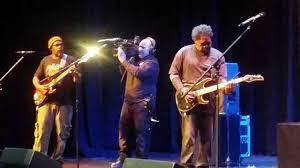The Laura Quinkan Indigenous Dance festival passes ‘these skills, stories and culture down to the next generation’
- Follow our Australia news live blog for the latest updates
- Get our morning and afternoon news emails, free app or daily news podcast
Mala, an Indigenous songman is speaking the music of deep bassy didgeridoo. As his vocal lines of grunts and rhythmic shrieks, backed by cadenced clapsticks, reach a crescendo, he invites the crowd to join him and the Yarrabah Barna dancers in the red dust circle.
“It is only because of our old people that we have survived, but now we need you,” Mala says. “We need you to stand with us and give us our voice.”
With these words spectators become performers, in a symbolic ritual of the coming together of dancers and onlookers, black and white, in a potent form of inclusion.



Since its inception in the early 1980s the Laura Quinkan Indigenous Dance festival has brought together Indigenous communities from across Cape York, the Torres Strait and beyond.
The festival MC, Mark Hogan, says many non-Indigenous Australians and international tourists also travel to Laura, four hours’ north of Cairns, for the opportunity to engage with living Aboriginal culture.
“Every community coming up here to dance has a different story, their songlines – and those stories are told in dance,” he says.
“Whether it’s a momentous event or even just the story of a particular hunt – it’s these stories that the Indigenous dancers are sharing with the audience.”

Held 15km south of Laura, amid a landscape rich with ancient rock art depicting giant Quinkan spirits, the biennial event is one of the largest and longest running cultural gatherings of Aboriginal and Torres Strait Islander people in Australia.
- Sign up for Guardian Australia’s free morning and afternoon email newsletters for your daily news roundup
The traditional Bora corroboree ground, set among the sparse eucalyptus and melaleuca trees, with black cockatoos flying overhead, is a sacred site for the local Ang-Gnarra people. Groups have travelled from as far south as Albury in New South Wales to take part.
Although not overtly political in nature, this year’s festival is given potency by its timing at the end of Naidoc week and in the lead up to the voice to parliament referendum. The yes campaign has a strong presence, with evening discussions explaining the significance of the moment to roughly 5,000 spectators.skip past newsletter promotion
Sign up to Morning Mail
Free daily newsletter
Our Australian morning briefing breaks down the key stories of the day, telling you what’s happening and why it matters
https://www.google.com/recaptcha/api2/anchor?ar=1&k=6LdzlmsdAAAAALFH63cBVagSFPuuHXQ9OfpIDdMc&co=aHR0cHM6Ly93d3cudGhlZ3VhcmRpYW4uY29tOjQ0Mw..&hl=en&type=image&v=0hCdE87LyjzAkFO5Ff-v7Hj1&theme=light&size=invisible&badge=bottomright&cb=rsm22wpakresPrivacy Notice: Newsletters may contain info about charities, online ads, and content funded by outside parties. For more information see our Privacy Policy. We use Google reCaptcha to protect our website and the Google Privacy Policy and Terms of Service apply.
after newsletter promotion


Jilian Faith, a teacher of Indigenous children in Herberton in Queensland’s Atherton Ranges, has been coming to the festival for 25 years and says this year is the biggest yet.
“I first came here in 1988 and we hired a car with mates from university. We were told not to take it off road but boy did we need to take it off road to get here in those days,” she says.
Throughout the three days of the festival, each of the eight clan dance groups perform three times, leading to a dance-off on the final day for the Laura Dance Shield. The Pormpuraaw traditional dancers are announced as the overall winners by Australian Indigenous actor and celebrity, Ernie Dingo.

Hailing from the western Gulf of Carpentaria, the troupe of 40 dancers travelled for over nine hours to get to Laura.
Syd Bruce Shortjoe, a freshwater man from the Kugo clan, says he has been coming to Laura since its beginning, originally as a dancer and now as a senior songman for the group, many of whom are teenagers.
“Laura is important because we are also passing these skills, stories and culture down to the next generation,” he says.
“Because someday we the older ones won’t be here. I am in my middle age so now I like to teach what these songs are all about, and which clan group they belong to.”
NICC = National Indigenous Cultural Centre – works with Walkabout Australia – we give you indigenous products, indigenous music, aboriginal art – news (we are your indigenous home…








